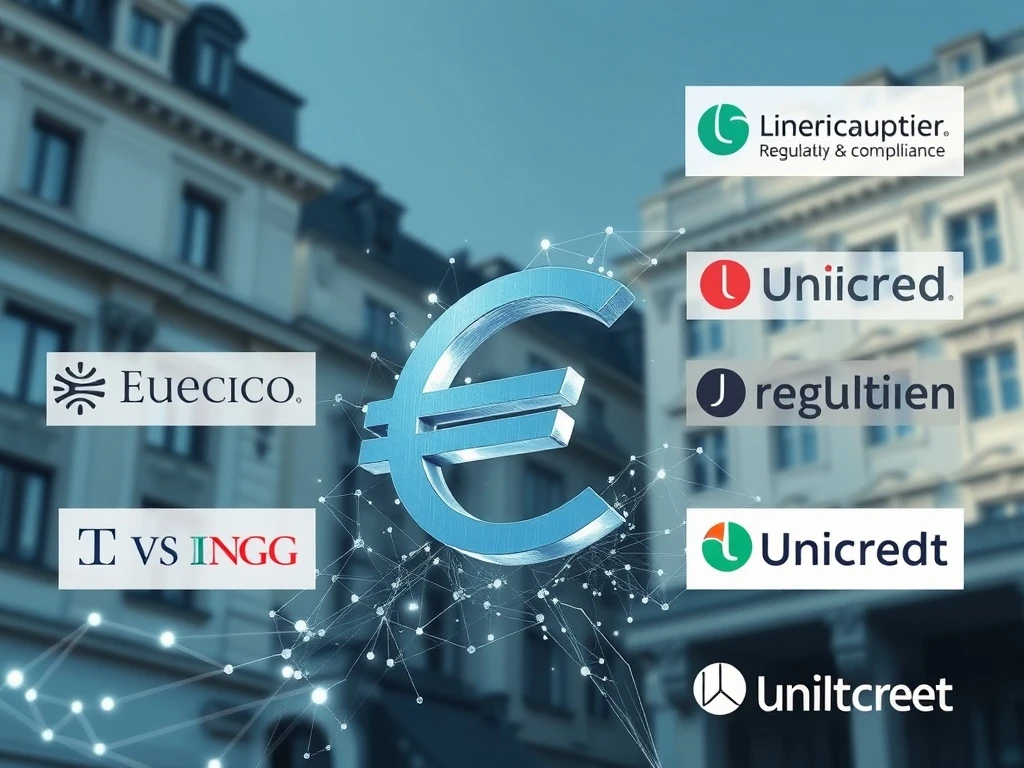Pioneering Euro Stablecoin: European Banks Unite for Transformative MiCA-Compliant Digital Payments

The cryptocurrency world constantly evolves. Today, a significant development is reshaping the landscape for financial institutions. Nine prominent European Banks, including Dutch ING and Italy’s UniCredit, are collaborating. They aim to launch a MiCA-compliant Euro Stablecoin. This initiative promises to revolutionize Digital Payments and strengthen Europe’s position in the global digital economy. The planned launch in the second half of 2026 marks a pivotal moment for traditional finance entering the digital asset space.
The Genesis of Europe’s MiCA-Compliant Euro Stablecoin
A consortium of major European banks has formally announced a joint venture. Their mission is to introduce a euro-pegged stablecoin. This new digital asset will strictly adhere to Europe’s Markets in Crypto-Assets (MiCA) framework. MiCA provides a comprehensive regulatory structure. It ensures consumer protection and market integrity within the European Union. Consequently, this stablecoin aims to become a trusted European payment standard. It will operate within the rapidly expanding digital ecosystem.
The announcement specifically highlights the strategic importance of this project. It seeks to provide a local alternative to the currently US-dominated stablecoin market. This move supports Europe’s broader goal of achieving strategic autonomy in payments. Such independence is crucial for regional economic stability and innovation. Floris Lugt, ING’s digital asset lead, emphasized this collaborative spirit. “Digital payments are key for new euro-denominated payments and financial market infrastructure,” he stated. “We believe this development requires an industry-wide approach, and it’s imperative that banks adopt the same standards.”
A United Front: Key European Banks and Their Vision
The initiative brings together a powerful group of financial institutions. Alongside ING and UniCredit, several other leading banks from eight EU member states are involved. These include:
- Spain’s CaixaBank
- Denmark’s Danske Bank
- Austria’s Raiffeisen Bank International
- Belgium’s KBC
- Sweden’s SEB
- Germany’s DekaBank
- Another Italian lender, Banca Sella
These founding members have established a new company. It is headquartered in the Netherlands, ING’s home country. This entity will oversee the stablecoin’s development and ongoing management. The banking consortium has also indicated openness to other banks joining the project. This inclusive approach strengthens the potential for widespread adoption. It fosters a truly pan-European digital payment solution.
Unlocking Efficiency with Digital Payments and Cross-Border Capabilities
The forthcoming Euro Stablecoin promises substantial advancements in payment efficiency. According to ING’s statement, users can expect “near-instant, low-cost payments and settlements.” This represents a significant upgrade from traditional banking systems. Furthermore, the stablecoin will enable 24/7 access to Cross-Border Payments. This continuous availability removes geographical and time-zone barriers. It facilitates smoother international transactions for businesses and individuals alike.
Beyond basic transactions, the stablecoin is designed with advanced functionalities. It will offer programmable payments. This feature allows for automated, conditional transactions. Such capabilities improve supply chain management. For example, payments can release automatically upon delivery confirmation. It also enhances digital asset settlements. This covers a broad spectrum, from traditional securities to various cryptocurrencies. Therefore, the stablecoin offers a versatile tool for modern financial operations. It truly bridges the gap between conventional finance and the digital economy.
Navigating the MiCA Regulation Landscape
The Markets in Crypto-Assets (MiCA) framework is a landmark regulation. It provides legal clarity for crypto assets within the European Union. For stablecoins, MiCA establishes stringent requirements. Issuers must maintain sufficient reserves. These reserves must be segregated and held in secure, low-risk assets. This ensures stability and protects consumers. The regulation also imposes strict governance rules. It demands transparent operations and robust risk management. Consequently, the banks’ commitment to a MiCA-compliant Euro Stablecoin is crucial. It signifies a dedication to regulatory adherence and investor confidence. This approach differentiates it from less regulated digital assets. It positions the stablecoin as a reliable financial instrument.
MiCA’s provisions cover authorization, operational requirements, and market abuse prevention. These measures create a safer environment for digital asset adoption. By operating under MiCA, this new euro stablecoin gains significant credibility. It appeals to institutional investors and large corporations. They prioritize regulatory certainty. This compliance ensures the stablecoin integrates smoothly into existing financial infrastructures. It fosters broader acceptance across the European economic zone.
Strategic Autonomy and Future Implications for Digital Payments
Europe’s ambition for strategic autonomy extends to its financial infrastructure. The development of a native Euro Stablecoin directly supports this goal. Currently, US-dollar-pegged stablecoins dominate the global market. Creating a robust euro-denominated alternative reduces reliance on foreign currencies and systems. This enhances financial sovereignty for the EU. It also promotes the euro’s role in the digital economy. The initiative demonstrates Europe’s proactive stance in shaping the future of finance.
This stablecoin could profoundly impact various sectors. Businesses engaging in international trade will benefit from faster, cheaper settlements. Financial institutions will explore new product offerings. They can leverage programmable money for innovative services. Moreover, the project sets a precedent. It shows how traditional financial players can embrace blockchain technology responsibly. The collaborative model involving multiple European Banks is a powerful testament. It highlights a shared vision for a more efficient, interconnected, and regulated digital financial future. This evolution will likely drive further innovation in Digital Payments across the continent.
Conclusion: A New Era for European Finance
The joint effort by ING, UniCredit, and other prominent European banks to develop a MiCA-compliant Euro Stablecoin represents a monumental step. It promises to deliver significant advantages in efficiency, cost, and accessibility for Cross-Border Payments. This project is not merely about launching a new digital asset. It embodies Europe’s commitment to innovation, strategic independence, and robust regulatory oversight. As the launch approaches in 2026, the financial world will watch closely. This initiative has the potential to redefine digital finance. It sets a new standard for collaboration between traditional banking and the evolving blockchain ecosystem.







